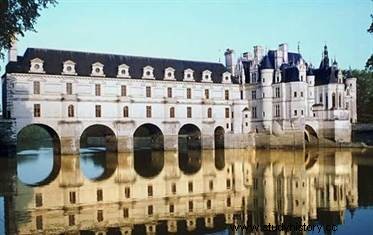 The castles of the Loire constitute a set of castles, royal and seigniorial residences, built from feudal times until the 17th century between Gien and Angers, along the Loire and its tributary valleys. They represent the splendor of an era, that of the Renaissance. During the Italian wars, the French sovereigns discovered Italian architectural refinement. They then decided to give a “royal” look to their residences and transformed their castles or had new ones built. In total, it is considered that the Loire Valley has, apart from the royal castles, nearly 1,200 castles, mansions and other buildings of character, including Chambord, Blois, Amboise, Chaumont and Chenonceaux.
The castles of the Loire constitute a set of castles, royal and seigniorial residences, built from feudal times until the 17th century between Gien and Angers, along the Loire and its tributary valleys. They represent the splendor of an era, that of the Renaissance. During the Italian wars, the French sovereigns discovered Italian architectural refinement. They then decided to give a “royal” look to their residences and transformed their castles or had new ones built. In total, it is considered that the Loire Valley has, apart from the royal castles, nearly 1,200 castles, mansions and other buildings of character, including Chambord, Blois, Amboise, Chaumont and Chenonceaux.
The Loire Valley, an attractive region
In the 15th and 16th centuries, sumptuous royal residences appeared in Orléanais, Touraine and Anjou. These regions are not lacking in attractions. The climate is mild and sunny, and the verdant nature has an undeniable charm. Far from the borders, they are generally spared from wars. Their geographical position, between the South and the North of the country, proved advantageous for the French sovereigns at a time when they were striving to complete centralization. After the Hundred Years War, the castles lost their defensive function.
They become real comfortable, bright and luxurious royal residences. With the Italian wars, the French discovered Italian architectural refinement. They then transpose it within their own constructions. The first palaces are the work of masons who follow their inspiration, hence their exuberance. Later castles, the work of architectural theorists, are more sober.
Italian influence and the classical period
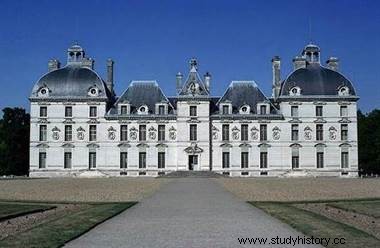 In 1496, Charles VIII's return from Italy initiated Italian influence in architecture. The main buildings of the Château d'Amboise (rebuilt from 1490) open to the light, the circulation galleries of Blois (built by Louis XII from 1498) announce a new refinement. The architectural developments characteristic of the Renaissance found their full expression at the beginning of the 16th century, under the reign of Francis I.
In 1496, Charles VIII's return from Italy initiated Italian influence in architecture. The main buildings of the Château d'Amboise (rebuilt from 1490) open to the light, the circulation galleries of Blois (built by Louis XII from 1498) announce a new refinement. The architectural developments characteristic of the Renaissance found their full expression at the beginning of the 16th century, under the reign of Francis I.
From his wars in Italy, the sovereign brought back the taste of the Italian Renaissance. The north house of Blois (begun in 1515), Chambord (in 1519) involve great Italian artists - architects, sculptors, painters. The mixture of brick and stone, which dominated the constructions erected under Charles VIII and Louis XII (Gien, Blois), gave way to white tufa, which became the construction material par excellence. Brick reappears under the reign of Henri IV and Louis XIII, as in the castles of Sully or Brissac.
In the 17th century, the classical style, marked by the balance of forms and symmetry, reached the shores of the Loire. A few buildings bear the mark of this period:the unfinished wing of the Château de Blois, where Gaston d'Orléans dreamed of setting up his court (1635-1638), Ménars (built around 1646 and future property of the Marquise de Pompadour), Brissac (completely renovated from 1608) and especially Cheverny (1604-1634), with harmonious proportions.
Château de Chambord
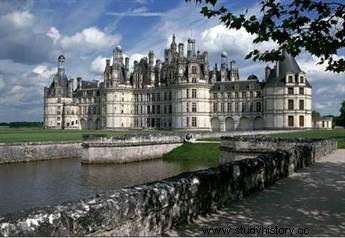 This huge palace perfectly illustrates the transition between medieval architecture and Renaissance architecture with its lanterns, its white stones, its terraces and its many openings. A double spiral staircase rises in the middle of the guard room. Probably designed by Leonardo da Vinci, it includes a cage with two propellers. Those who use it can see each other, but they do not meet. It is richly decorated in the Italian taste and reaches the central lantern, 32 meters high. If Chambord inherited a feudal plan, with a central keep and ditches filled with water, it only served as a hunting palace.
This huge palace perfectly illustrates the transition between medieval architecture and Renaissance architecture with its lanterns, its white stones, its terraces and its many openings. A double spiral staircase rises in the middle of the guard room. Probably designed by Leonardo da Vinci, it includes a cage with two propellers. Those who use it can see each other, but they do not meet. It is richly decorated in the Italian taste and reaches the central lantern, 32 meters high. If Chambord inherited a feudal plan, with a central keep and ditches filled with water, it only served as a hunting palace.
We do not know the name of the architect who designed it. The masters Denis Sourdeau, Pierre Nepveu dit Trinqueau and Jacques Coqueau presided over the work, which began in 1519. François I is suspected of wanting to impress Henri VIII and Charles V because he received the latter there with great pomp and gave sumptuous receptions. On the other hand, he resides only a few weeks in this residence which symbolizes the centralization of power.
The immense park of Chambord today covers a hunting reserve which perpetuates an activity very popular with the court, at the origin of the construction of the castle. The majestic double spiral staircase, the multiple terraces, the roofs that seem carved, all these elements make Chambord one of the splendors of the Loire castles.
Amboise Castle
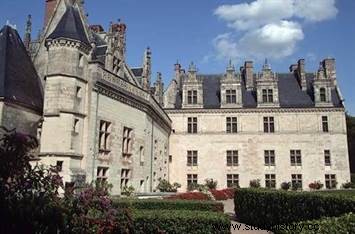 Amboise is built on a rocky promontory on the banks of the Loire. In 1495, Charles VIII returned from the wars in Italy, accompanied by Italian architects. He wants to give his home the prestige of a royal palace. Boccador and Fra Giocondo are among the architects of the castle, while Pacello is in charge of the gardens. The reconstruction includes a Renaissance wing with the Minimes tower and its rich Italian decorations. When the king died there in 1498, work was interrupted. They were completed under Louis XII and under François I, who spent the first three years of his reign there.
Amboise is built on a rocky promontory on the banks of the Loire. In 1495, Charles VIII returned from the wars in Italy, accompanied by Italian architects. He wants to give his home the prestige of a royal palace. Boccador and Fra Giocondo are among the architects of the castle, while Pacello is in charge of the gardens. The reconstruction includes a Renaissance wing with the Minimes tower and its rich Italian decorations. When the king died there in 1498, work was interrupted. They were completed under Louis XII and under François I, who spent the first three years of his reign there.
All that remains today of this vast ensemble is the Logis du Roi (whose facade faces the Loire), the Saint-Hubert chapel and two towers called Hurtault tower and Minimes tower. The Château d'Amboise is a Gothic construction:in accordance with medieval aesthetics, the ornamentation of the Logis du Roi is concentrated on the upper parts (cornice, skylight) and the verticality directs the elevation.
In addition, ingenious arrangements have been made as in the Hurtault and Minimes towers which are stair towers whose screws are without steps so that the ramp can be climbed by riders or light teams. But the most beautiful element of the castle is undoubtedly the Saint-Hubert chapel whose stone ornamentation, often compared to lace, is reminiscent of Flemish altarpieces. The names of Flemish artists such as Corneille de Nesve appear in the archives and attest that this chapel with its rich flamboyant decoration benefited from foreign contributions.
The castle of Chaumont-sur-Loire
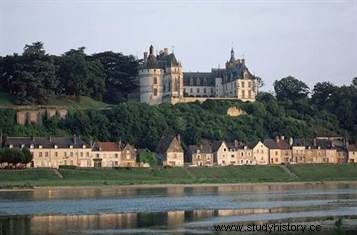 Chaumont-sur-Loire was the seat of a fortress built by the Counts of Blois in the 10th century. In 1465, Louis XI, King of France, ordered the destruction of this old castle, property of Pierre d'Amboise, while it was compromised in the league of Public Good. Four years later, the latter recovered his property and the castle was rebuilt by his son Charles I of Amboise between 1473 and 1475. The construction of the castle was completed by Charles II between 1498 and 1510. On the death of Henry II, Diane de Poitiers is obliged to cede the Château de Chenonceaux to Catherine de Médicis in exchange for that of Chaumont which she takes possession of.
Chaumont-sur-Loire was the seat of a fortress built by the Counts of Blois in the 10th century. In 1465, Louis XI, King of France, ordered the destruction of this old castle, property of Pierre d'Amboise, while it was compromised in the league of Public Good. Four years later, the latter recovered his property and the castle was rebuilt by his son Charles I of Amboise between 1473 and 1475. The construction of the castle was completed by Charles II between 1498 and 1510. On the death of Henry II, Diane de Poitiers is obliged to cede the Château de Chenonceaux to Catherine de Médicis in exchange for that of Chaumont which she takes possession of.
At the end of the 19th century, the de Broglie family acquired the château, which became a place for sumptuous parties. The castle was restored by the architect Pierre-Etienne Sanson, the stables were fitted out with stalls with enameled mangers and the park, entirely redesigned by Henri Duchêne, received electric lighting. In 1940, the castle was classified as a historical monument. It became state property in 1938. Since 1992, the International Garden Festival of Chaumont-sur-Loire has been set up every year in the castle park, where contemporary artists from around the world have created daring gardens.
The castle of Blois
The fortress of Blois overlooks the Loire. Residence of the Counts of Châtillon, it has existed since the 13th century. The poet Charles d'Orléans inherited this possession. He stays there after his return from England. His son Louis XII carried out transformations again and made Blois his favorite residence. He furnishes the interior in the Italian style. François I had a new wing built to enrich the château. Le Boccador designed its rich facade in the French style. An elegant carved staircase cuts the side of the courtyard. It is embedded in an octagonal cage and can be used as a stand.
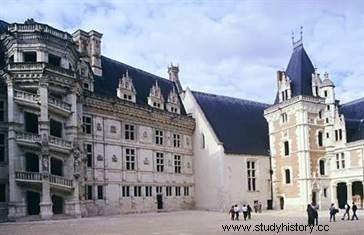 Despite several major projects, particularly under the reign of Henry IV, few achievements remain from the various works undertaken between the end of the 16th and the beginning of the 17th century. Under Louis XIII, the architect François Mansart was commissioned to rebuild the entire building, but the work was interrupted in 1637. Only the building occupying the back of the courtyard saw the light of day. The facade, with a sober classical order, is organized around a richly sculpted avant-corps dedicated to the glory of the prince. Inside, only the high domed vaulted room is complete, which houses the staircase, built late (in 1932) on the model of that of the Château de Maisons, another achievement by François Mansart.
Despite several major projects, particularly under the reign of Henry IV, few achievements remain from the various works undertaken between the end of the 16th and the beginning of the 17th century. Under Louis XIII, the architect François Mansart was commissioned to rebuild the entire building, but the work was interrupted in 1637. Only the building occupying the back of the courtyard saw the light of day. The facade, with a sober classical order, is organized around a richly sculpted avant-corps dedicated to the glory of the prince. Inside, only the high domed vaulted room is complete, which houses the staircase, built late (in 1932) on the model of that of the Château de Maisons, another achievement by François Mansart.
Since 1869, the Château de Blois has housed a Museum of Fine Arts in the apartments of the Louis XII wing. A room is devoted to the iconography of the death of the Duke of Guise, assassinated in the castle in 1588 on the orders of Henri III, during the wars of religion.
Château de Chenonceau
The most original of the Loire castles is built on the site of a completely uncomfortable former defensive fortress. Thomas Bohier, Receiver of Finances of Charles VIII, buys the house and builds his castle. His wife leads the work with great taste. It innovates by having stairs with straight banisters built. François I took over the château and Henri II gave it to his mistress, Diane de Poitiers. It is to the latter that we owe the bridge with five arches which spans the Cher. On the death of Henry II, Catherine de Medici demanded Chenonceau against Chaumont. On the bridge that gives access to the residence, the queen built a double-storey gallery decorated in the Italian style. The first floor serves as a ballroom.
Loire castles, a popular tourist destination
Properties of the State (Azay-le-Rideau, Chambord, Angers) and cities (Saumur), or private residences, the vast majority of the castles of the Loire are open to the public. Refurnished (Chaumont, Azay-le-Rideau), restored (Talcy) or transformed into a museum (Hunting Museum in Gien; Horse Museum and Museum of Decorative Arts in Saumur; Gallery of the Apocalypse Tapestry in Angers) , they attract hundreds of thousands of French and foreign tourists every year. Chambord, Blois, Amboise, Villandry, Azay-le-Rideau and Chenonceaux come first, which alone accounts for some 900,000 annual visitors.
In 2000, the Loire Valley was listed as a World Heritage Site by UNESCO.
To go further
- The castles of the Loire, by Alain Cassaigne. From Borée, 2019.
- The castles of the Loire Valley, by Jean-Marie Pérouse de Montclos. Victory Square, 2000.
- Guide du Routard Châteaux de la Loire 2020. Hachette tourism, 2019.
